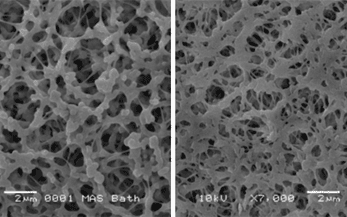Stringing us along − filamentous bacteria in MBRs

Simon Judd has over 35 years’ post-doctorate experience in all aspects of water and wastewater treatment technology, both in academic and industrial R&D. He has (co-)authored six book titles and over 200 peer-reviewed publications in water and wastewater treatment.
There can be few things more confounding in MBR operation and maintenance than the development of filamentous bacteria in the biotank. These are 'string-like' micro-organisms which can normally discerned by staring down a microscope, with different species apparently prevailing under different conditions.
These species are, in fact, nearly always present at some concentration, but it is only at higher levels that they start to cause problems. The most visible manifestation of the latter is the formation of a stable brown foam, sometimes called 'moussing' due to its resemblance to chocolate mousse (though its olfactory properties are obviously somewhat less pleasant than that of the foodstuff).
Since the filamentous bacteria − the most prevalent species seemingly being Nocardia, Microthrix parvicella and type 021N − are hydrophobic in nature, they are also associated with membrane fouling. Thus, moussing is associated both with 'poor biology' and fouling − and hence the emphasis of practitioners on 'getting the biology right'. 'Good biology' normally means stable operating conditions with respect to things like organic and nutrient loading, dissolved oxygen concentration, sludge concentration and temperature. So, attributes for promoting good biology do not differ so much from those associated with suppressing membrane fouling.
However, there are other string-like materials, discussed previously on this website (see the feature article 'When sludge goes bad'), which do not relate at all to biology, are just as onerous, and are not readily controlled by any conventional means.
The widely recognised phenomenon of 'ragging' or 'braiding' appears to be attributable to the agglomeration of small lengths (<10mm) of cotton wool to form long rags which can be tens of cm in length. These can then readily clog both the membrane channels and the membrane aerators.
Little more is known about the phenomenon, but it seems unlikely that it is associated with hydrophobicity or indeed fouling: cotton wool is hydrophilic in nature and its agglomeration to form rags appears to be purely physical with no chemical or biochemical component. It is also very specific to cotton wool, and possibly other cotton derivatives: very recent work in the Catalonian region of Spain has revealed similar phenomena for an MBR fed with laundry wastewater (containing suspended lint).








